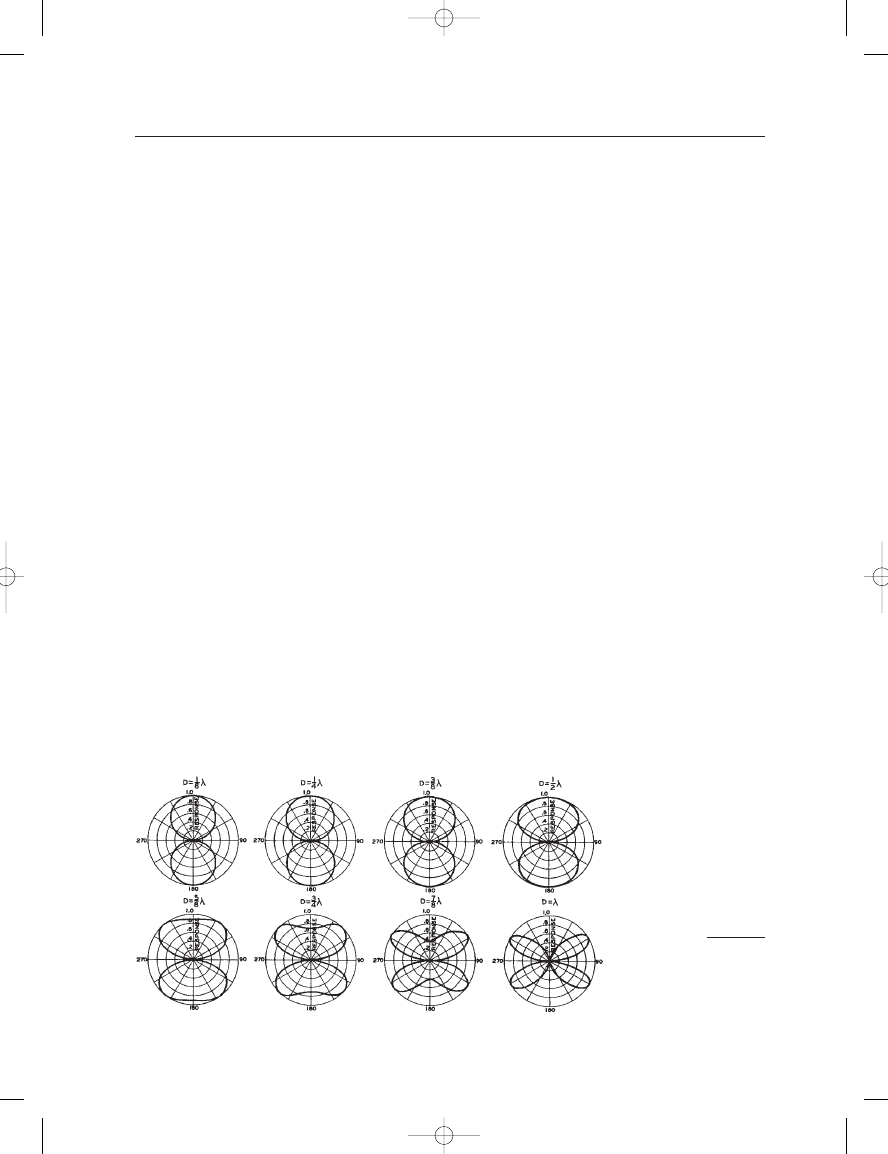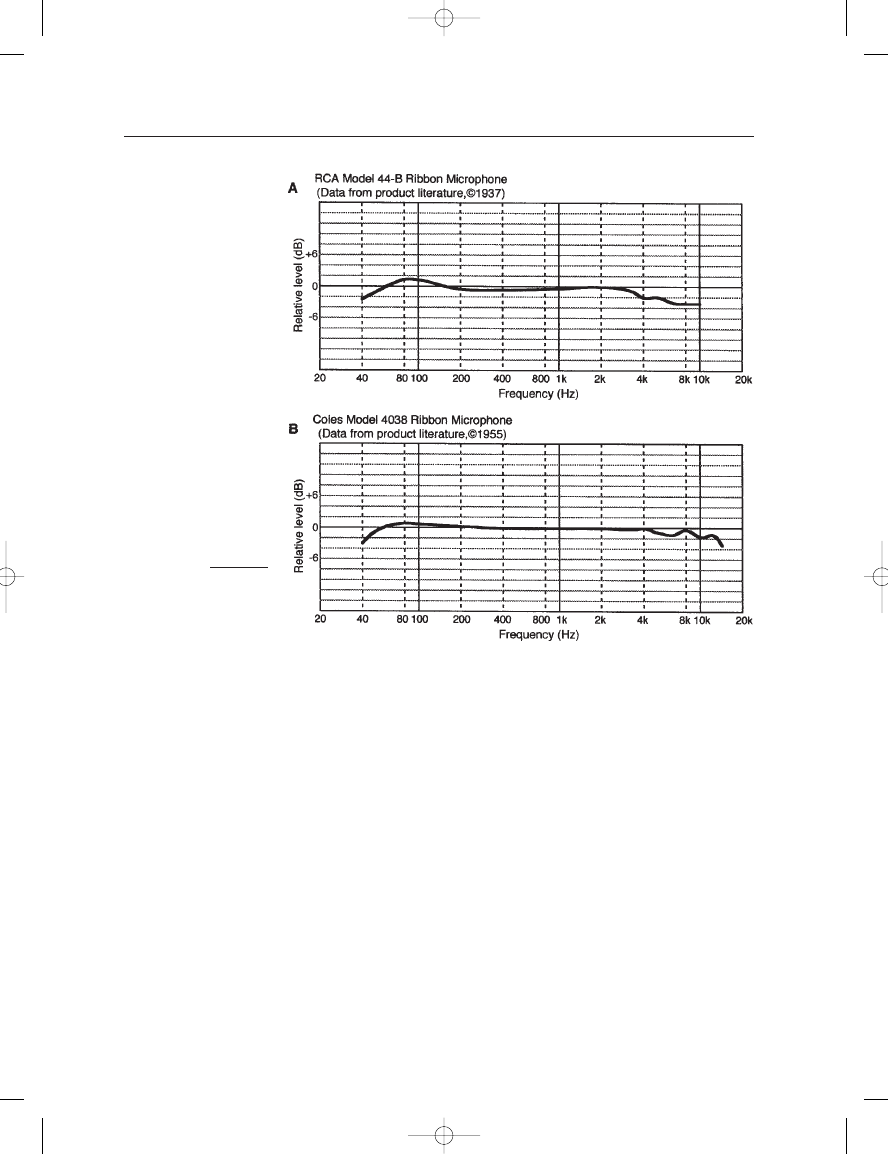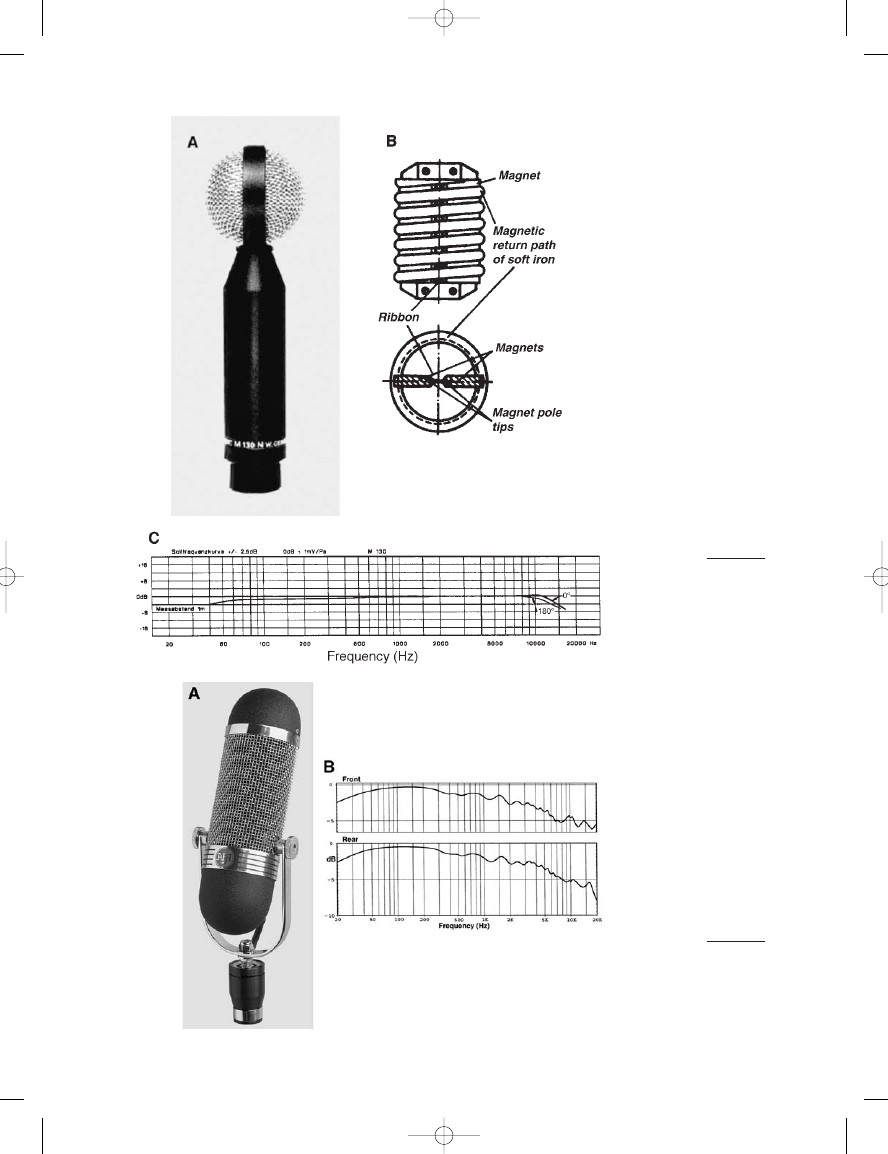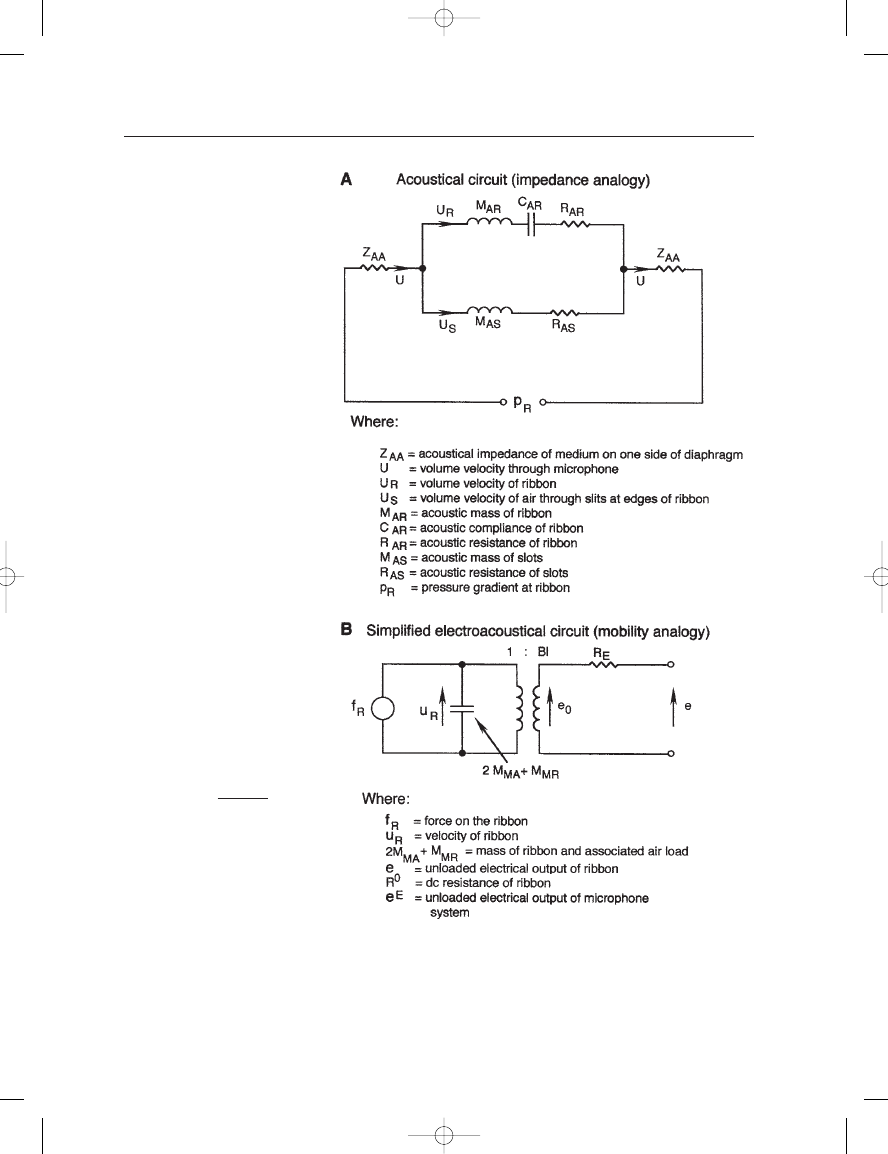ВУЗ: Казахская Национальная Академия Искусств им. Т. Жургенова
Категория: Книга
Дисциплина: Не указана
Добавлен: 03.02.2019
Просмотров: 17258
Скачиваний: 51

THE MICROPHONE BOOK
58
will raise the sensitivity by 6 dB but will adversely affect vertical direc-
tional response at high frequencies. Doubling the path length around the
polepieces would also provide a 6-dB increase in sensitivity but would
compromise the HF performance of the microphone because of the over-
all increase in microphone size.
The area where many modern improvements have taken place is in
magnetics. The use of higher energy magnets, along with new magnetic
circuit materials and topology, has made it possible to achieve enough
improvement in base sensitivity to allow further beneficial tradeoffs,
including shorter ribbons, with their better behaved polar response and
HF performance. In most magnetic designs, the choice and dimensioning
of materials is made so that the flux through the polepieces is effectively
saturated, and thus uniform throughout the length of the gap.
Because of the extremely low electrical output from the ribbon, a
step-up transformer is normally installed in the microphone case. A
transformer turns ratio of about 20:1 can be used to match the very low
impedance of the ribbon to a 300 ohm load. The open circuit sensitivity
of a typical ribbon microphone, operating without an output trans-
former, is normally in the range of 0.02 mV/Pa. The addition of a step-
up transformer raises the system open circuit sensitivity to the range of
0.5–1.OmV/Pa.
RESPONSE CURVES FOR RIBBON GRADIENT MICROPHONES
The design simplicity of the ribbon microphone produces a predictable,
uniform pattern up to the frequency where d
(5/8). Olson (1957)
presents the theoretical polar data shown in Figure 4-8. Note that as the
wavelength approaches the internal dimensions of the microphone, the
pattern flattens slightly on-axis, eventually collapsing to produce zero
on-axis response, with polar response of four equal off-axis lobes.
Figure 4–9 shows on-axis response curves for typical commercial rib-
bon gradient microphones. The curve shown at A is from RCA product
literature for the model 44-B ribbon microphone. The data shown at B
FIGURE 4–8
Polar response of a
theoretical ribbon gradient
microphone as a function
of
and d. (Olson, 1957.)
Earg_04.qxd 14/9/04 2:38 PM Page 58

4: The Pressure Gradient Microphone
59
is for the Coles model 4038 microphone. Note that the Coles exhibits
slightly flatter and more extended HF response.
Figure 4–10A shows details of the beyerdynamic Model M 130 rib-
bon microphone. It is perhaps the smallest, and flattest, ribbon micro-
phone available today, with the entire ribbon assembly contained within
a sphere 38.5 mm in diameter. Details of the ribbon structure are shown
at B, and the microphone’s response at 0
and 180 is shown at C.
The more recent AEA model R-84 has much in common with the
earlier RCA designs in that it has a large format ribbon. This model is
shown in Figure 8–11A, with front and back response curves at B. Note
that the vertical scale is expanded and that the response, though
extended to 20 kHz, has very much the same general contour as the
response curve of the RCA 44.
EQUIVALENT CIRCUIT FOR A RIBBON GRADIENT MICROPHONE
Figure 4–12A shows the equivalent circuit for a ribbon gradient micro-
phone using the impedance analogy (Beranek, 1954). Ignoring the effects
of the slits between the ribbon and polepieces and damping in the
system, we can simplify the circuit to the form shown at B. Here, the
FIGURE 4–9
Typical frequency response
curves for ribbon gradient
microphones RCA 44-B
(A); Coles 4038 (B).
Earg_04.qxd 14/9/04 2:38 PM Page 59

FIGURE 4–10
Beyerdynamic M 130
ribbon microphone:
photo (A); details of ribbon
structure (B); frequency
response (C). (Data courtesy
of beyerdynamic.)
FIGURE 4–11
AEA R-84 ribbon
microphone: photo (A);
front and back response
curves (B). (Data courtesy
of AEA.)
Earg_04.qxd 11/10/04 5:39 PM Page 60

4: The Pressure Gradient Microphone
61
FIGURE 4-12
Equivalent circuits for a
ribbon gradient
microphone; acoustical
circuit (A); simplified
electroacoustical circuit (B).
(Data after Beranek,
1954.)
Earg_04.qxd 14/9/04 2:39 PM Page 61

THE MICROPHONE BOOK
62
mobility analogy is used to give an equivalent electromechanical circuit
over the range from 50 Hz to about 1 kHz. As can be seen from the cir-
cuit, the microphone presents very nearly a pure mass reactance to the
acoustical driving signal.
The output voltage is given by:
(4.5)
where u is the component of air particle velocity perpendicular to the rib-
bon,
d is the path length around the microphone, S is the effective area
of the ribbon, and 2M
MA
M
MR
represents the mass of the ribbon and
its associated air load on both sides.
A well-designed ribbon gradient microphone can handle fairly high
sound pressure levels in normal studio applications. The moving system
is however displacement limited at LF due to the constraints of its design
resonance frequency.
THE CAPACITOR GRADIENT MICROPHONE
Figure 4–13 shows three forms of capacitor gradient microphone. The
single-ended form shown at A is most common, but its asymmetry does
cause a slight HF response difference between front and back. Some
designers will place a dummy perforated electrode, which is not polarized,
at the front to compensate for this, as shown at B. The push-pull design,
shown at C, doubles the output voltage for a given diaphragm excursion
relative to the other forms, but is complicated by the required biasing
method.
As we discussed in the section entitled Definition and Description of
the Pressure Gradient, the capacitor gradient microphone operates in a
resistance-controlled mode. This requires that the diaphragm has an
undamped resonance in the midband and that considerable viscous air
damping be applied to it by the many small holes through the backplate
or backplates. There is a practical limit to the amount of damping that
is applied, however. Figure 4-14 shows the damping applied progres-
sively, and a typical operating point is indicated at curve 3. Carrying the
damping further, in order to gain extended LF response, will result in a
very low sensitivity, degrading the self noise floor of the microphone sys-
tem. Generally, in normal use the LF rolloff will be at least partially com-
pensated by proximity effect (see next section).
Figure 4-15 shows on-axis frequency response curves for a typical high
quality capacitor gradient microphone, indicating the degree of LF rolloff
that may be tolerated. As in the case of the ribbon microphone, on-axis dif-
fraction effects are used to advantage in maintaining extended HF response.
When judging the merits of various figure-8 microphones, most engi-
neers will choose a ribbon over a capacitor. This may account for the fact
that there are relatively few capacitor models available. The natural LF
resonance of the ribbon, a vital ingredient in its design, provides
extended LF response, which most engineers (and artists) appreciate.
e
0
u
Bl
0
d
2M
MA
M
MR
S
cos
(
)
Earg_04.qxd 14/9/04 2:39 PM Page 62